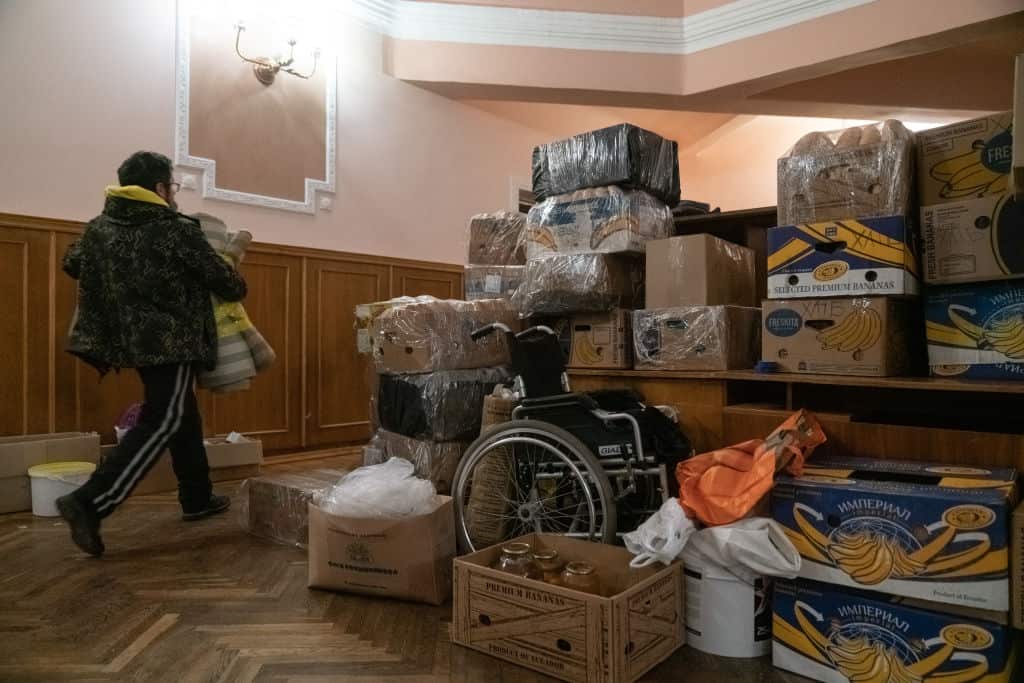In this issue
- Ukraine invasion: Crypto resistance
- Ethereum: Pricey but performing
- China: Jailhouse block
From the Editor’s Desk
Dear Reader,
As Russia’s war in Ukraine escalates, so too does opposition to it, and the use of cryptocurrency to fund the fight against Moscow’s invasion appears to be very much part of the picture.
Millions of dollars worth of Bitcoin and other cryptos have been pouring in from around the world in response to a Ukrainian government call for donations, skirting fiat payment services, many of which do not allow fundraising for military purposes.
It’s not the first time crypto has been used to finance a war effort — pro-democracy forces in Myanmar and Houthi rebels in Yemen have turned to crypto to advance their causes, among others. Crypto has also found its way into less fraught corners of politics, such as congressional races in the United States and electioneering in South Korea.
Given crypto’s clearly significant potential as a means of funding political causes and conflicts, it’s hardly surprising that governments such as China’s are continuing to come down hard on it. Its announcement of the harsh new anti-crypto measure on the exact same day as Moscow launching its invasion feels like a stark warning that such activities are very much on Chinese authorities’ radar and will be dealt with firmly.
Russia seems to have ruled out a similar move against crypto, perhaps not wanting to narrow its options further as sanctions and its sweeping exclusion from the global financial system begin to bite. But in Beijing, the latest development suggests that authorities’ long battle to crush crypto has reached a decisive point.
Still, even in the most tightly controlled, authoritarian countries on earth, people find ways around the rules, as crypto traders have in China. Money — to borrow a phrase from Hong Kong’s democracy movement — is like water: mostly able to be contained, but never completely. And cryptocurrency, thanks to its democratizing ideals, is more difficult to contain than most.
Until the next time,
Angie Lau,
Founder and Editor-in-Chief
Forkast.News
1. Ukraine’s digital donors

By the numbers: Ukraine — over 5,000% increase in Google search volume.
Cryptocurrencies are playing a role in financing Ukraine’s resistance to Russia’s invasion of its territory as donations to the country’s military and humanitarian aid workers flow in from around the world.
- Dozens of countries have now imposed sanctions on Russia as part of a campaign to target its economy and finance sector, and some Russian banks have been cut off from the SWIFT international banking network. The ruble has lost 22.5% of its value against the U.S. dollar over the past seven days.
- The value of Bitcoin, however, has moved in the opposite direction, heading higher following a fall shortly after the invasion. BTC has risen 14.8% to US$43,963 in the past seven days, and is now a more valuable currency than the ruble.
- The global cryptocurrency market cap increased by US$200 billion on Tuesday after historically neutral Switzerland joined the list of nations imposing sanctions against Russia, further damaging the nation’s access to financial services.
- According to cryptocurrency research firm Kaiko, the volume of ruble-denominated Bitcoin trade surged to nearly 1.5 billion rubles (US$18 million) on Feb. 24, the day of the invasion, its highest level since last May.
- Concerned by the possibility that Russia might use cryptocurrencies to bypass international sanctions, Ukrainian Vice Prime Minister Mykhailo Fedorov on Sunday urged all major crypto exchanges to block the addresses of Russian users. Exchanges such as Binance have announced their support for sanctions, but have stopped short of pledging to impose restrictions on individuals’ private accounts.
- The Ukrainian government last Saturday announced on Twitter that it had opened Bitcoin and Ethereum wallets to accept donations in cryptocurrencies.
- The Patreon page of Come Back Alive, a Ukrainian NGO set up to help fighters and their families, was shut down for breaching the platform’s terms of service, which prohibit fundraising for military purposes. But Come Back Alive’s Bitcoin wallet had received US$8.6 million worth of BTC as of press time.
- A new decentralized autonomous organization named Ukraine DAO is auctioning a non-fungible token (NFT) of a Ukrainian flag, with bids having topped US$5.4 million by press time.
- “We don’t have time for traditional means of fundraising, and crypto has already proven to be the most efficient tool to offer immediate help,” Ukraine DAO co-founder Trippy Labs told Forkast.
Forkast.Insights | What does it mean?
The notion that Bitcoin is an inflation hedge is dead. But the role of Bitcoin as part of a parallel financial world, largely unencumbered by the power of governments, is still very much alive.
Crypto is back in the headlines, thanks to donors and exchanges helping move money into Ukraine, and also into the wallets of Russians, whose finances have been hit by sanctions.
As Russian banks have been disconnected from the global financial system, and the country’s access to foreign currency has been choked off, at least one lawmaker has reportedly floated the possibility the government could seize its own citizens’ cash.
Vladimir Putin and his cronies may have been able to control the way in which many Russians see the conflict, but they haven’t been as successful when it comes to covering up economic reality, and there have been large flows of cash into crypto. Record sums have been converted into USDT and Bitcoin as the ruble has shed much of its value. Meanwhile, tens of millions of dollars worth of cryptocurrency has poured into Ukraine.
As Russia tightens its grip on its neighbor, it’s losing control of crypto, and in turn, a measure of its ability to bully and cajole its own people — and others.
2. Ethereum still rocks the block

By the numbers: NFT — over 5,000% increase in Google search volume.
The number of unique non-fungible token (NFT) buyers on the Ethereum blockchain topped 1 million this past weekend, and the network’s infamous transaction fees have dropped to their lowest levels since August 2021, when they fell following its London upgrade.
- Ethereum’s London hard fork, as it is known, replaced an auction-based transaction fee mechanism with a base fee system and allowed optional tips for miners. The upgrade was designed to discourage miners from colluding to inflate transaction, or gas, fees.
- JPMorgan predicted in January that Ethereum could lose ground to rivals such as Solana due to its high fees.
- Ethereum’s average transaction fee was US$10.66 on Feb. 27, nearly 80% lower than in early January, but still high compared to Solana’s average of US$0.00025. Ethereum’s average gas fee was US$15.6 as of press time.
- NFT sales on Ethereum reached a total of US$2.23 billion in February, accounting for around 85% of sales across all blockchains tracked by data aggregator CryptoSlam. Solana recorded sales of US$135 million, just over 5% of NFT sales during the month.
- Ethereum’s London hard fork burns base fees in transactions, and so far has wiped out more than 1.9 million ETH (US$5.74million).
Forkast.Insights | What does it mean?
Ethereum may lag behind its rivals in terms of transaction speed and cost, but the projects building on it continue to outperform those on rival chains when it comes to innovation.
Over the last 30 days, among the 50 biggest NFT collections by sales volume, only five were not on Ethereum. Solana’s most active project, Solana Monkey Business, was ranked 41st by sales volume. No other blockchain had more than one project in the top 50 during the period. That’s telling.
Although the crypto faithful espouse the virtues of faster, cheaper chains, the more successful projects building on Ethereum have buried any mention of the mechanics it is built on, instead focusing on broader messaging to attract new users.
On the websites of the top 10 projects by sales volume, only CryptoPunks makes any mention of the token standard upon which it has been created or the blockchain it uses.
What these Ethereum projects have realized is that mass adoption is less about preaching the holy trinity of blockchain — speed, scalability and security — and more about conveying an experience that looks and feels familiar to regular internet users.
A fast blockchain, it seems, isn’t all it’s cracked up to be.
3. Chinese traders face time inside

China’s highest court has made cryptocurrency trading punishable by prison time, with the toughest sentences for engaging in it being more than 10 years long.
- The Supreme People’s Court of China identified cryptocurrency trading as a means of illegal fundraising in its latest judicial interpretation of criminal law, which came into effect on Tuesday. A judicial interpretation is the Supreme People’s Court’s official guidance on how a law is to be enforced.
- According to the court, cryptocurrency trading meets the definition of illegal fundraising when four conditions are met: funds are raised via crypto from members of the public; fundraising targets are unspecified; returns on capital and interest are promised; and activities that violate laws and regulations.
- Over-the-counter trading, cryptocurrency exchanges, initial coin offerings, initial decentralized exchange offerings, yield farming and cryptocurrency futures exchanges all fall within the definition of illegal fundraising, according to Zhang Xiaoxiao, the founder of ChainAudit, which provides consulting services on economic crime to China’s public security departments.
- Illegal fundraising involving sums of more than 50 million yuan (US$7,919,000) or 5,000 people, or which causes direct losses of 25 million yuan to donors, can lead to a prison sentence of more than 10 years.
Forkast.Insights | What does it mean?
China’s Supreme Court, through its latest judicial interpretation, has added yet another weapon to the government’s arsenal to crack down on crypto-related activities.
China has long taken a hostile attitude toward crypto. As early as 2013, it banned banks from handling transactions involving Bitcoin. In 2017, Chinese authorities made it illegal for businesses to raise funds through initial coin offerings. Then, last year, China imposed a blanket ban on crypto transactions and mining.
The Supreme People’s Court’s latest move shows that Beijing is sparing no effort in its crusade against crypto. Chinese courts have repeatedly ruled that crypto investments are not protected by law, and a high court in Guangdong Province listed a crypto-related virtual asset dispute as one of its 10 key internet cases of 2021.
With its new prison sentences, Beijing is attempting to deter criminals and ordinary traders alike from using crypto. It’s hard to imagine how China could escalate its fight against the crypto sector any further as its dragnet snares ordinary, enterprising individuals, and not simply those seeking to prey on people’s gullibility and profit from scams.
In applying such harsh measures across the board, Chinese authorities are clearly trying to hammer the final nail in the country’s crypto coffin. Whether they’ll prevail against resourceful individuals seeking to circumvent the rules while staying out of trouble — as a number of crypto miners surreptitiously have been doing — remains to be seen.




